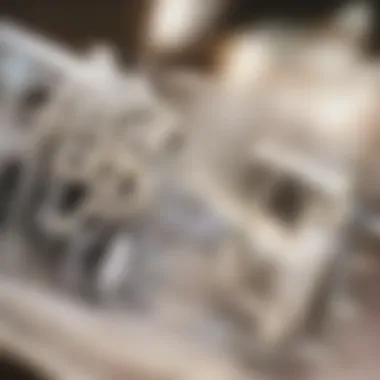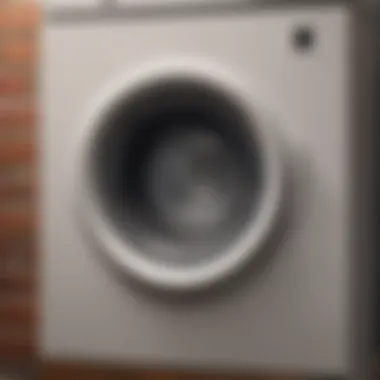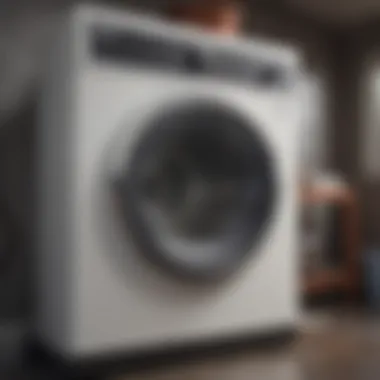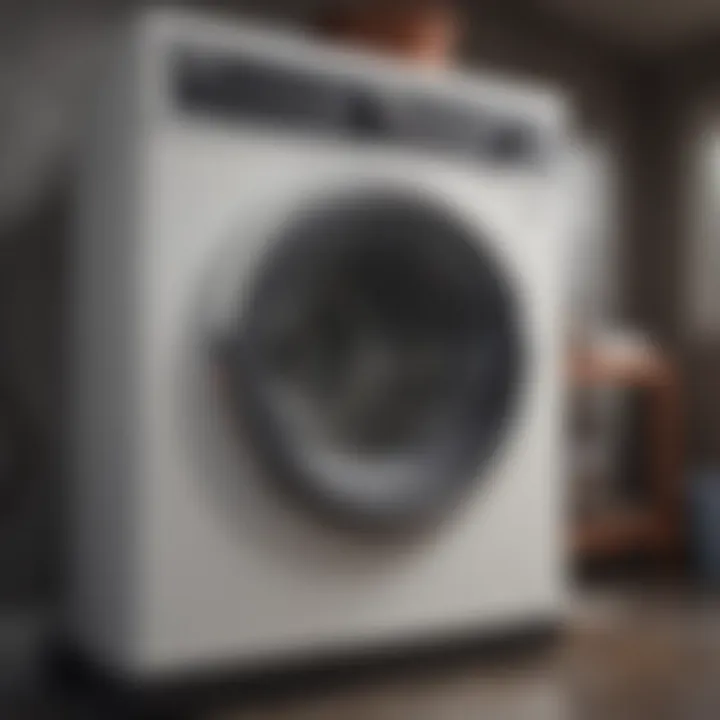Essential Guide to Dryer Lint Cleaning Techniques


Intro
Cleaning the lint from your dryer is crucial. Lint buildup can cause inefficiency and even pose serious fire hazards. Many home owners underestimate how important regular maintenance is for their appliances. A clean dryer performs better than a clogged one. This guide will assist you in understanding how to maintain your dryer effectively.
Lint can accumulate in various parts of the dryer. It tends to gather in the lint trap, vent, and even within the dryer itself. Regular cleaning not only extends the dryer’s lifespan but also enhances performance.
In the following sections, we will discuss the necessary tools, safety precautions, step-by-step instructions for cleaning the lint, and tips to prevent future buildup. Ensuring a clean dryer is not just about efficiency. It's about safety for you and your family.
Proper cleaning should be a part of your regular laundry routine, allowing for a safer and more efficient drying process.
Tools Needed
Before you begin cleaning, gather the following tools:
- A vacuum with a hose attachment
- A long, flexible brush specifically for dryer vents
- A microfiber cloth
- A pair of gloves for hygiene
- A flashlight for visibility in tight spaces
Having these tools at hand will make the cleaning process easier and more thorough. You want to ensure that every inch of lint is addressed.
Step-by-Step Cleaning Process
Cleaning a dryer is straightforward if you follow these steps:
- Unplug the dryer: Always start by disconnecting the power source to prevent accidental shocks.
- Remove the lint trap: Take out the lint filter. Clean it under warm water to remove any residue. Let it dry completely.
- Use a vacuum: With the vacuum’s hose attachment, clean out the lint trap housing. Make sure to get into corners where lint may accumulate.
- Access the vent: Disconnect the vent from the dryer. Use the long brush to remove lint from inside the vent, pushing it carefully toward the exit. Repeat this process until no lint is visible.
- Check the exterior vent: Look outside to ensure that the vent is free of obstructions. If necessary, use the vacuum to remove debris from the outside as well.
- Wipe down the drum: Use the microfiber cloth to wipe down the interior of the drum, removing any stray lint and ensuring cleanliness.
- Reassemble and test: Once everything is cleaned and dry, reassemble the dryer, plug it back in, and run a short cycle to ensure it is functioning correctly.
Regular maintenance can save you from costly repairs and hazards in the future.
Safety Precautions
Keep these safety tips in mind while cleaning:
- Always unplug the dryer before starting maintenance.
- Use protective gear such as gloves and a mask if you are sensitive to dust.
- Be cautious when moving the dryer. Heavy appliances can shift and cause injury.
Tips to Prevent Lint Buildup
Prevention is key to ensure your dryer remains lint-free. Here are some tips:
- Clean the lint filter after every load.
- Check and clean the vent regularly, ideally once a year.
- Avoid overloading the dryer as it may trap lint.
- Ensure that your dryer is properly installed to minimize lint collection.
Implementing these practices not only enhances dryer performance but also significantly reduces fire risk.
By following this guide, your dryer will be more efficient and less hazardous. Regular maintenance of your dryer is essential for a smooth laundry experience.
Intro to Dryer Maintenance
Maintaining a dryer is a fundamental yet often overlooked aspect of household upkeep. The dryer is a vital appliance in many homes, facilitating the drying of clothes and linens, thereby contributing to overall household efficiency. However, without proper maintenance, this convenience can become a safety hazard and can lead to decreased performance over time. Focusing on dryer maintenance, particularly the cleaning of lint, is essential. It not only preserves the appliance’s functionality but also extends its lifespan.
The importance of cleaning lint within the dryer cannot be overemphasized. Lint buildup is a natural occurrence as clothes are dried. Yet, when ignored, this buildup can obstruct airflow, causing the dryer to work harder. This can lead to increased energy consumption and higher utility bills. Moreover, lint is highly flammable, creating a potential fire hazard if it accumulates unnoticed. Maintaining a clean dryer helps ensure that it operates efficiently and safely, thus preserving the well-being of the household.
An additional consideration is the impact of regular dryer maintenance on the quality of laundry. Clean dryers provide a better drying experience, preventing musty odors and ensuring that clothes are thoroughly dried. Taking time to establish a maintenance routine can save time, energy, and costs in the long run, making it a wise decision for any homeowner.
By prioritizing dryer maintenance, specifically the cleaning of lint, homeowners can enjoy a safer, more efficient appliance and contribute to the overall health of their living environment.
Importance of Cleaning Lint
Cleaning lint from your dryer is not merely a matter of aesthetics; it is crucial for operational safety and efficiency. Lint, consisting of tiny fibers from fabrics, accumulates in the lint trap and other areas over time. Regular removal prevents the lint from clogging the system, ensuring optimal airflow.
A dryer clogged with lint will often take longer to dry clothes, which is a clear sign of inadequate maintenance. This inefficiency not only frustrates users but also results in higher energy bills. Moreover, the overheating of lint-clogged dryers poses a serious fire risk.
In summary, cleaning lint is an indispensable part of dryer maintenance, significantly contributing to the appliance's safety and efficiency.
Consequences of Neglect


Neglecting the cleaning of lint inside your dryer can have serious repercussions. The most immediate consequence is impaired efficiency. A lint-filled dryer will struggle to expel air, causing the appliance to work harder while consuming more energy. This increased workload can lead to premature breakdowns, requiring costly repairs or even replacement.
Furthermore, the buildup of lint is a fire hazard. According to the National Fire Protection Association, dryers are involved in thousands of home fires each year, often due to neglected lint accumulation. Even a small amount of forgotten lint can ignite, posing a threat to the entire household.
The continuous neglect of lint cleaning can also lead to unpleasant odors in the laundry. Moisture trapped inside a cluttered dryer creates an environment where mold can thrive, leaving clothes smelling musty and damp.
Overall, the consequences of neglecting lint cleaning are dire. From financial implications due to increased energy costs and potential repairs, to safety issues concerning fire hazards, the neglect of this simple maintenance task should not be underestimated. The prudent approach is to prioritize regular cleaning to safeguard both the appliance and the household.
Understanding Lint Accumulation
Understanding lint accumulation is critical for maintaining the efficiency and safety of your dryer. Lint is a byproduct of the drying process, and it can pose significant risks if not addressed. Accumulated lint not only hampers the dryer’s performance but can also lead to hazardous situations, such as fires. Therefore, grasping the nature of lint and the processes that contribute to its buildup is essential for any dryer owner.
What is Lint?
Lint consists of tiny fibers that shed from clothes during the drying cycle. These fibers mainly come from cotton, polyester, and other fabrics. Every load of laundry contributes some lint, so it’s common for households to generate a noticeable amount over time. Lint is not just a nuisance; it can affect the airflow in your dryer, reducing its efficiency and increasing energy consumption. While small amounts of lint are natural, excessive accumulation can create serious problems.
Where Does Lint Collect?
Lint can collect in various places within the dryer system:
- Lint Trap: This is the first line of defense in reducing lint accumulation. It collects lint that is generated during the drying process.
- Vent Duct: Lint can escape the lint trap and accumulate in the vent duct, which can block airflow.
- Exhaust Port: The area where the dryer vents to the outside can be another spot where lint accumulates, sometimes becoming trapped if not properly maintained.
Ensuring proper airflow is key to a safe and effective drying process. Regular checks and cleanings help prevent lint from building up in these areas.
Ignoring these locations can lead to severe blockages and necessitate costly repairs. Understanding where lint collects allows for effective maintenance practices, helping to keep your dryer running optimally.
Tools Required for Cleaning
Understanding the tools necessary for cleaning lint from your dryer is key to ensuring the job is thorough and effective. Without the right equipment, you might miss critical areas where lint can accumulate. Using quality tools can also prevent damage to your dryer, enhancing its lifespan and performance over time. An organized approach and the right implements assist in maintaining a safe and efficient laundry appliance.
Basic Cleaning Tools
For general cleaning of your dryer, a few fundamental tools will suffice. These tools help tackle the lint that tends to build up in various parts of the dryer. The essential tools include:
- Vacuum Cleaner: Equipped with a hose attachment, it can effectively remove lint from the lint trap, interior, and venting system.
- Soft Brush or Cloth: These items are useful to wipe down surfaces where lint may settle. A microfiber cloth can capture lint without leaving any residue.
- Lint Roller: Ideal for removing lint from the lint trap and any affected areas in the dryer. It is easy to use and doesn't require much effort.
- Screwdriver: Some parts of the dryer may need to be removed to allow for more thorough cleaning. A basic set of screwdrivers will help you access these areas.
Having these basic tools ensures you can address the most common cleaning tasks associated with dryer lint accumulation. Regular use of these can yield noticeable improvements in dryer efficiency.
Specialized Tools for Deep Cleaning
While basic tools are sufficient for routine cleaning, specialized tools can greatly enhance the efficiency of deep cleaning sessions. These tools target areas that are often neglected or harder to reach. Here are the specialized tools to consider:
- ** Dryer Vent Cleaning Kit**: This kit usually includes a flexible brush and rods. The brush connects via rods to reach deep into the venting system and remove accumulated lint.
- Drill Attachment: If you have a dryer vent cleaning kit, a drill attachment can speed up the cleaning process. Utilize it to rotate the brush quickly, ensuring a thorough clean.
- Inspection Camera: For serious lint buildup, using a small inspection camera can help identify hidden lint pockets. This can assist you in targeting specific areas during cleaning.
- Air Duster: Useful for blowing out lint from tight spaces or electronic components. An air duster provides precision without needing direct contact to avoid damaging sensitive parts.
Opting for these specialized tools makes it easier to perform extensive cleaning routines. They not only reveal difficult-to-access lint but also encourage a proactive safety routine for long-lasting dryer health.
Regular maintenance with the right tools is essential for safe and efficient dryer operation.
Equipped with both basic and specialized tools, you improve the overall cleaning strategy, ensuring your dryer operates optimally.
Step-by-Step Cleaning Process
The Step-by-Step Cleaning Process is integral to maintaining your dryer’s functionality and ensuring safety. A systematic approach reduces the risk of accidents and machine malfunctions. By following detailed procedures, you enhance the effectiveness of the clean and minimize the chance of lint accumulation in the future. This section elaborates on each step involved in the cleaning process, emphasizing its significance and the benefits derived from it.
Preparing the Dryer
Before starting any cleaning procedure, preparing the dryer is crucial. Disconnect the appliance from the power source to prevent any accidental start during cleaning. Ensure that the area around the dryer is clear of any obstacles or flammable materials. This not only enables easier access but also enhances safety. You should have all necessary tools and cleaning supplies within reach.
- Unplug the dryer.
- Clear the area of any items or debris.
- Gather cleaning tools such as a vacuum, brush, and cleaning cloths.
Ensuring this preparation phase is completed will allow the cleaning process to proceed smoothly.
Removing Lint from the Filter


The lint filter is the first line of defense against lint buildup. Regularly cleaning this filter is vital for your dryer’s performance. To begin, remove the filter from its slot and visually inspect it. Use a soft brush or your fingers to remove any lint clinging to it.
- Rinse the filter under warm water if it's heavily soiled.
- Allow it to air dry completely before reinserting.
Cleaning the lint filter not only improves air circulation within the dryer but also reduces the risk of fire.
Clearing Lint from the Vent System
Lint can accumulate in the vent system, leading to restricted airflow. This could result in overheating situations. Start by disconnecting the vent duct from the back of the dryer. Use a vacuum with a narrow attachment to remove lint from the duct.
- Consider using a brush specifically designed for this purpose to reach deeper sections.
- Ensure that you clean both the inside and outside of the vent.
Regularly clearing the vent system is essential to maintain efficient dryer operation.
Checking the Exhaust Duct
The exhaust duct needs inspection after cleaning the vent system. Ensure that it is free of obstructions. Look for any signs of damage, such as cracks or bends, which could impede airflow. If necessary, replace it to ensure optimal functioning.
- Reconnect the duct securely.
- Test to ensure there are no air leaks.
A thorough examination of the exhaust duct is necessary to keep your dryer effective and safe.
Final Inspection
The final inspection is a necessary step after all cleaning activities. Check all parts and ensure everything is reattached securely. Power on the dryer for a short time to observe if it’s operating smoothly. During this phase, verify if there are any unusual noises or smells that may indicate a problem.
- Document any issues for further analysis.
- Ensure to schedule the next cleaning session in your maintenance calendar.
Performing a final inspection solidifies your cleaning efforts and ensures that your dryer is running at its best, prolonging its lifespan.
Safety Precautions
Ensuring safety while cleaning your dryer is critical. This section emphasizes precautions necessary to prevent accidents and injuries. Cleaning lint from a dryer can be a straightforward task, but neglecting safety protocols can lead to significant risks, including fires and electrical hazards. By following proper procedures, you can protect yourself and enhance the efficiency of your appliance.
Disconnecting Power
One of the most important safety precautions is disconnecting power to the dryer before starting any maintenance work. Whether your dryer is electric or gas, ensuring it is completely turned off eliminates the risk of accidental activation while you are cleaning.
- Unplugging the Dryer: For electric dryers, simply unplugging the appliance is straightforward. Locate the power cord and pull it from the outlet. This direct action prevents any electrical flow.
- Shutting off Gas Supply: If your dryer operates on natural gas, locate the gas supply valve. Turn it to the off position to ensure no gas leaks during the cleaning. This precaution is essential for avoiding potential explosions or fires.
- Double-Check: Always double-check that the dryer is disconnected. A good practice is to try pressing the start button after you've powered it down. If it does not respond, you are safe to proceed.
"Power should always be disconnected before undertaking any maintenance work to avoid the risk of electric shock or fire."
Using Protective Gear
Using appropriate protective gear is another effective way to enhance safety during the cleaning process. Here are some items you should consider:
- Gloves: Wearing gloves will protect your hands from sharp edges and lint irritants. They also provide better grip when handling tools or removing parts.
- Dust Mask: Lint can cause respiratory issues, especially for those with allergies or asthma. A dust mask prevents inhalation of fine particles, ensuring a safer cleaning experience.
- Safety Goggles: Protecting your eyes is crucial, particularly when using tools or disassembling parts. Safety goggles can shield against debris that may come loose during cleaning.
By implementing these safety precautions, you significantly reduce the risk associated with dryer maintenance. Prioritizing safety helps ensure your tasks go smoothly and without incident.
Tips for Preventing Lint Buildup
Maintaining your dryer isn't just about cleaning it regularly; it also involves taking proactive steps to prevent lint accumulation. This is significant not only for enhancing the efficiency of your appliance but also for prolonging its lifespan. Preventive measures can save you from frequent repairs and ensure a balanced operation. By implementing these tips, you can create a safer environment in your home, where the risk of fire hazards diminishes.
Choosing the Right Dryer Settings
Selecting appropriate dryer settings is crucial in managing lint buildup. Each fabric type has different requirements for drying.
Here are some considerations:
- Heat Settings: Use lower heat settings for delicate fabrics. High heat can cause more lint production.
- Cycle Duration: Shorter drying cycles are beneficial, particularly when drying smaller loads. This prevents lint from having adequate time to accumulate within the dryer.
- Sensor Drying: Choose dryers equipped with moisture sensors, like those from Whirlpool or LG. They automatically adjust drying time based on the moisture content of clothes, reducing the risk of overheating and lint generation.
Adopting the right settings can lead to less wear on clothing and reduced lint production.


Frequency of Cleaning
How often you clean your dryer can significantly affect lint buildup. Regular cleaning should be part of any laundry routine to maintain optimal performance.
Consider implementing these practices:
- Lint Trap: Check the lint trap before each load. This should be a non-negotiable step to ensure maximum airflow.
- Monthly Deep Cleaning: Schedule a deep cleaning of your dryer every month. This includes freeing lint from the vent and checking the exhaust duct to prevent blockages.
- Seasonal Inspection: Every three months, inspect the entire dryer system for lint buildup in unreachable areas. This proactive approach can mitigate risks.
Regular cleaning will help maintain efficiency and safety in your dryer usage.
Common Misconceptions About Dryer Maintenance
Many homeowners harbor misconceptions regarding the maintenance of their dryers. These misunderstandings can lead to serious safety risks and inefficiencies in the dryer’s operation. This section aims to clarify these misconceptions by focusing on two primary areas: lint trap myths and cleaning frequency misunderstandings. It is essential for users to have a clear understanding of these aspects to ensure not only optimal performance but also safety.
Lint Trap Myths
One prevalent myth is that cleaning the lint trap after every use is sufficient for preventing lint buildup in the dryer as a whole. While it is imperative to clean the lint trap, this action alone does not fully address lint accumulation within the dryer vent system. The lint trap captures a significant portion of lint, but the remaining particles can travel further into the venting system, creating blockages. Additionally, homeowners may believe that if the lint trap appears clean, the dryer is functioning optimally. This notion is incorrect; lint can still accumulate in the venting areas that are less visible. Therefore, it’s crucial to conduct periodic deep cleaning of both the lint trap and the entire vent system.
Another commonly held belief is that using dryer sheets can help minimize lint accumulation. While dryer sheets may make laundry smell pleasant and reduce static cling, they do not prevent lint buildup. In fact, the residue from dryer sheets may contribute to lint accumulation in the dryer lint trap over time. Thus, focusing on regular cleaning practices remains vital for maintaining a safe and efficient dryer.
Cleaning Frequency Misunderstandings
Another domain where misconceptions exist is regarding the frequency of dryer cleaning. Some individuals operate under the assumption that maintaining a clean lint trap suffices, dismissing the need for a thorough cleaning of the dryer vent system. This belief can be detrimental. Ignoring the vent system can result in reduced airflow, which may lead to overheating and, at worst, a fire hazard. Therefore, a consensus among experts is to clean the dryer vent system at least once a year, noting that households that do extensive laundry might need to clean it more frequently.
People may also think that the length of the venting duct has no impact on cleaning frequency. In reality, longer venting systems can lead to increased lint accumulation due to the distance the lint must travel. This situation necessitates more regular cleaning interventions. Understanding these cleaning requirements helps extend the lifespan of the appliance and maintains its efficiency.
"Regular maintenance of your dryer can prevent possible fire hazards and promote energy efficiency."
In summary, addressing these common misconceptions about dryer maintenance is essential. Accurate knowledge regarding lint accumulation and appropriate cleaning frequency promotes both safety and efficiency. Readers are encouraged to evaluate their own practices, ensuring that they are not falling prey to these myths. By doing so, they enhance the effectiveness of their laundry routine and mitigate any risks associated with neglecting dryer maintenance.
When to Seek Professional Help
Understanding when to consult a professional for dryer maintenance is essential. Several factors can indicate the need for expert intervention. Recognizing these signs ensures not just the longevity of your appliance but also your safety.
Signs of a Clogged System
A dryer may show numerous symptoms indicating it requires professional attention. Look out for the following signs:
- Increased Drying Time: If clothes are taking longer than normal to dry, this could be a sign of lint buildup in the vent system.
- Overheating: If the dryer feels unusually hot, it can signify a ventilation issue, which can lead to fires.
- Unpleasant Odors: A burning smell can point to lint being trapped in the system, creating a risky scenario.
- Lint Accumulation: Noticeable lint collecting around the dryer or inside the vent could mean a serious clog.
- Error Codes: Modern dryers may display error codes that suggest a problem with the exhaust or airflow.
If you are experiencing one or more of these issues, it may be the right time to call a professional. Attempting to clean significant clogs without proper knowledge can lead to further damage or safety hazards.
Manufacturer Recommendations
Every dryer brand has specific guidelines regarding maintenance and cleaning. These are often found in the user manual.
- Regular Inspections: Most manufacturers recommend inspecting your dryer and vent system at least once a year.
- Clean the Vent: Many brands suggest a thorough cleaning of the vent system every six months to prevent buildup.
- Professional Check-ups: Depending on the model, manufacturers may recommend professional service if the dryer shows any unusual function or wear.
Following these recommendations not only ensures your dryer operates efficiently but also maintains any existing warranty. If you have doubts about your dryer functioning correctly, don’t hesitate to reach out to a service professional.
Epilogue
Proper maintenance of your dryer is essential for several reasons. One of the most important aspects that this article has tackled is the cleaning of lint from inside your dryer. This can significantly improve the efficiency of your appliance. A dryer that is free from lint works better, saving you time on drying cycles and reducing energy consumption. Moreover, a clean dryer decreases the risk of fire hazards, which is a major safety concern.
The benefits of regular maintenance extend beyond just operational efficiency. Ensuring that lint does not build up helps in prolonging the lifespan of the dryer. When airflow is not obstructed, the internal components do not overheat. This ultimately reduces the need for repairs and replacements, which can be costly and inconvenient. Therefore, it is prudent to view dryer maintenance as an investment rather than a chore.
In summary, keeping your dryer clean minimizes risks of malfunction, enhances performance, and creates a safer environment.
Summary of Key Points
- Regularly clean lint from the dryer to ensure maximum efficiency.
- Accumulated lint poses fire hazards and reduces airflow.
- Maintenance can prolong the life of the dryer and reduce repair costs.
- Implementing proper cleaning techniques leads to better drying times.
Encouragement for Regular Maintenance
Establishing a routine for dryer maintenance will not only make the appliance work more efficiently but also enhance safety. Set a schedule based on usage; if you use your dryer frequently, bi-weekly cleans may be necessary. For less frequent use, monthly checks may suffice.
Be proactive about lint accumulation. Every time you use the dryer, remove lint from the filter afterward. This small action can make a big difference. Additionally, consider scheduling a thorough lint cleaning every 6 to 12 months, which includes vent cleaning and checking ductwork.
Taking these steps can help maintain optimal functionality, allowing you to enjoy a reliable laundry experience. Incorporating maintenance into your routine can transform it from a mundane task into a proactive habit that safeguards both your appliance and your home.



